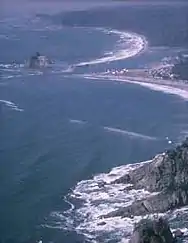Olympic Coast National Marine Sanctuary
The Olympic Coast National Marine Sanctuary is one of 15 marine sanctuaries administered by the National Oceanic and Atmospheric Administration (NOAA), an agency of the U.S. Department of Commerce. Declared in 1994, the sanctuary encompasses 3,189 square miles (8,260 km2) of the Pacific Ocean along the Olympic Peninsula of Washington state, from Cape Flattery in the north, to the mouth of the Copalis River, a distance of about 162.5 miles (261.5 km).[1] Extending 25 to 40 miles (40 to 64 km) from the shore, it includes most of the continental shelf, as well as parts of three important submarine canyons, the Nitinat Canyon, the Quinault Canyon and the Juan de Fuca Canyon. For 64 miles (103 km) along the coast, the sanctuary shares stewardship with the Olympic National Park.[1] Sanctuary stewardship is also shared with the Hoh, Quileute, and Makah Tribes, as well as the Quinault Indian Nation.[2] The sanctuary overlays the Flattery Rocks, Quillayute Needles, and Copalis Rock National Wildlife Refuges.[3]
| Olympic Coast National Marine Sanctuary | |
|---|---|
IUCN category IV (habitat/species management area) | |
 Aerial view of Teahwhit Head and James Island | |
| Location | Western Washington state |
| Coordinates | 48°00′N 124°48′W |
| Area | 3,189 sq mi (8,260 km2)[1] |
| Established | 1994 |
| Governing body | National Oceanic and Atmospheric Administration |
References
- "Mapping". Olympic Coast National Marine Sanctuary.
- Matsumoto, Kendall (February 2022). "Meeting the Challenge of Climate Change: A Makah Tribal Leader Seeks Solutions to an Ocean Out of Balance". United States National Marine Sanctuary. National Oceanic and Atmospheric Administration. Retrieved 2022-03-06.
- "Sanctuary Fact Sheet". Olympic Coast National Marine Sanctuary.
External links
 Map of the sanctuary |
 Olympic Coast National Marine Sanctuary |